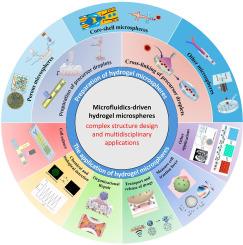Microfluidics-based hydrogel microspheres: Complex structure design and multidisciplinary applications
IF 3.9
3区 工程技术
Q3 ENERGY & FUELS
Chemical Engineering and Processing - Process Intensification
Pub Date : 2025-10-11
DOI:10.1016/j.cep.2025.110595
引用次数: 0
Abstract
Hydrogel microspheres have emerged as multifunctional three-dimensional biomaterial platforms, garnering significant research attention in biomedical and analytical fields. Their applications now extend to cutting-edge domains including controlled drug delivery, regenerative medicine, and biosensing technologies. Conventional fabrication methods such as emulsion techniques, three-dimension (3D) printing, and spray drying face inherent limitations in producing structurally sophisticated microspheres, particularly regarding inadequate product uniformity, high production costs, and scalability challenges. The breakthrough development of microfluidic technology has revolutionized the controllable fabrication of hydrogel microspheres, establishing itself as the most promising technology in this field. This review systematically summarizes recent advancements in microfluidics-based hydrogel microsphere preparation technologies, with particular emphasis on innovative strategies for constructing complex architectures and methodological breakthroughs. This review highlights, as a key insight, the unique capability of microfluidics to engineer architecturally sophisticated microspheres and their role in fostering convergence across disciplines like biomedicine and materials science. By critically synthesizing these advances, this work provides a foundational guide for future research, outlining clear pathways for overcoming current scalability and biocompatibility challenges to advance the development of personalized and smart functional microspheres.

基于微流体的水凝胶微球:复杂结构设计和多学科应用
水凝胶微球作为一种多功能的三维生物材料平台,在生物医学和分析领域得到了广泛的研究关注。它们的应用现在扩展到尖端领域,包括控制药物输送,再生医学和生物传感技术。传统的制造方法,如乳液技术、三维(3D)打印和喷雾干燥,在生产结构复杂的微球时面临固有的局限性,特别是在产品均匀性不足、生产成本高和可扩展性方面的挑战。微流控技术的突破性发展彻底改变了水凝胶微球的可控制造,使其成为该领域最有前途的技术。本文系统总结了基于微流体的水凝胶微球制备技术的最新进展,特别强调了构建复杂结构的创新策略和方法突破。这篇综述强调了微流体设计复杂微球结构的独特能力,以及它们在促进生物医学和材料科学等跨学科融合方面的作用。通过批判性地综合这些进展,本工作为未来的研究提供了基础指导,概述了克服当前可扩展性和生物相容性挑战的明确途径,以推进个性化和智能功能微球的发展。
本文章由计算机程序翻译,如有差异,请以英文原文为准。
求助全文
约1分钟内获得全文
求助全文
来源期刊
CiteScore
7.80
自引率
9.30%
发文量
408
审稿时长
49 days
期刊介绍:
Chemical Engineering and Processing: Process Intensification is intended for practicing researchers in industry and academia, working in the field of Process Engineering and related to the subject of Process Intensification.Articles published in the Journal demonstrate how novel discoveries, developments and theories in the field of Process Engineering and in particular Process Intensification may be used for analysis and design of innovative equipment and processing methods with substantially improved sustainability, efficiency and environmental performance.

 求助内容:
求助内容: 应助结果提醒方式:
应助结果提醒方式:


